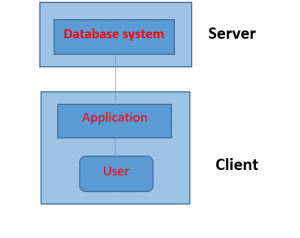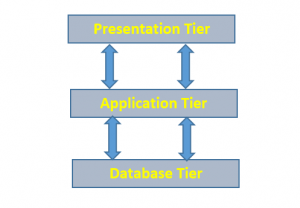Let’s learn about Database Architecture.
What is database architecture?
Database architecture uses programming languages to design particular types of software for businesses or organizations. A Database Management system is not always directly available for users and applications to access and store in it. A Database Management system can be centralized (all the data stored at one location), decentralized (multiple copies of a database at different locations), or hierarchical, depending upon its architecture.
DBMS architecture helps in the design, development, implementation, and maintenance of a database. A database stores critical information for a business. Selecting the correct Database Architecture helps in quick and secure access to this data.
There are three types of DBMS architecture
- Single tier architecture
- Two-tier architecture
- Three-tier architecture
Single tier architecture
In this type of architecture, the database is readily available on the client machine, any request made by the client doesn’t require a network connection to perform the action on the database.
- In this architecture, the database is directly available to the user. It means the user can directly sit on the DBMS and uses it.
- Any changes done here will directly be done on the database itself. It doesn’t provide a handy tool for end-users.
- The 1-Tier architecture is used for the development of the local application, where programmers can directly communicate with the database for a quick response.
Anytime you install a DB in your system and access it to practice SQL queries it is 1 tier architecture. But such architecture is rarely used in production.
For example, let’s say you want to fetch the records of employees from the database and the database is available on your computer system, so the request to fetch employee details will be done by your computer and the records will be fetched from the database by your computer as well. This type of system is generally referred to as a local database system.
Two-tier architecture
2-tier DBMS architecture includes an Application layer between the user and the DBMS, which is responsible to communicate the user’s request to the database management system and then send the response from the DBMS to the user. Such an architecture provides the DBMS extra security as it is not exposed to the End User directly. Also, security can be improved by adding security and authentication checks in the Application layer too.
In two-tier architecture, the Database system is present at the server machine and the DBMS application is present at the client machine, these two machines are connected with each other through a reliable network. Whenever the client machine makes a request to access the database present at the server using a query language like SQL, the server performs the request on the database and returns the result back to the client.
An application interface known as ODBC (Open Database Connectivity) provides an API that allows the client-side program to call the DBMS. Most DBMS vendors provide ODBC drivers for their DBMS.
- In the two-tier architecture, applications on the client end can directly communicate with the database at the server-side. For this interaction, APIs like: ODBC, JDBC are used.
- The user interfaces and application programs are run on the client-side.
- The server side is responsible to provide the functionalities like: query processing and transaction management.
- To communicate with the DBMS, client-side application establishes a connection with the server-side.
- In this, a single database server can be used by many client users.
Example: Most of Desktop Applications use 2-Tier Architecture.
Three-tier architecture
In the three-tier architecture, another layer is present between the client machine and server machine. In this architecture, the client application doesn’t communicate directly with the database systems present at the server machine, rather the client application communicates with server application and the server application internally communicates with the database system present at the server.
A 3-tier architecture separates its tiers from each other based on the complexity of the users and how they use the data present in the database. It is the most widely used architecture to design a DBMS.
- Database (Data) Tier – At this tier, the database resides along with its query processing languages. We also have the relations that define the data and their constraints at this level.
- Application (Middle) Tier – At this tier resides the application server and the programs that access the database. For a user, this application tier presents an abstracted view of the database. End-users are unaware of any existence of the database beyond the application. At the other end, the database tier is not aware of any other user beyond the application tier. Hence, the application layer sits in the middle and acts as a mediator between the end-user and the database.
- User (Presentation) Tier – End-users operate on this tier and they know nothing about any existence of the database beyond this layer. At this layer, multiple views of the database can be provided by the application. All views are generated by applications that reside in the application tier.
Multiple-tier database architecture is highly modifiable, as almost all its components are independent and can be changed independently.
- The 3-tier architecture contains another layer between the client and server. In this architecture, client can’t directly communicate with the server.
- The application on the client-end interacts with an application server which further communicates with the database system.
- End-user has no idea about the existence of the database beyond the application server. The database also has no idea about any other user beyond the application.
- 3-tier architecture is used in the case of large web applications.
Three-tier architecture is the most popular DBMS architecture.
The goal of Three-tier architecture is:
- To separate the user application and physical database.
- Program-data Independence.
- Support for multiple views of the data
Example of Three-tier Architecture: Facebook, any large website on the internet.
I hope guys like these posts and comment on Database Architecture.
Characteristics of Database Management System
Advantages of DBMS over file system


